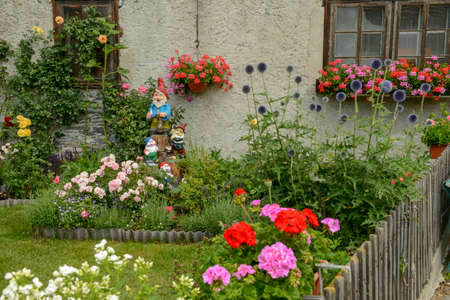Embracing the Cottage Garden Aesthetic
The cottage garden is a beloved hallmark of British landscape design, celebrated for its informal beauty and nostalgic charm. Steeped in history, this style originated in rural England, where practicality met whimsy—herbs, flowers, and vegetables grew side by side within hand-built boundaries. Today, embracing the cottage garden aesthetic means reviving this harmonious blend of function and enchantment in your own outdoor space. Think lush borders brimming with foxgloves, delphiniums, and hollyhocks, winding gravel paths edged with lavender, and an overall sense of relaxed abundance. The appeal of the cottage garden lies not only in its romantic appearance but also in its adaptability to modern living. Whether you’re working with a compact urban plot or a sprawling countryside retreat, this design ethos encourages creativity and resourcefulness—values especially relevant when working within a budget. By understanding the historical roots of the cottage garden and its enduring relevance, you can infuse your home with timeless British character while keeping costs delightfully modest.
Budget-Friendly Plant Choices
When crafting a quintessentially British cottage garden on a budget, clever plant selection is key. Opting for hardy perennials, heritage roses, and self-seeding annuals not only keeps costs low but also ensures your garden flourishes in the UK’s varied climate. These plants bring timeless charm, lush layers, and delightful seasonal changes—without requiring you to splurge at the garden centre.
Hardy Perennials: The Foundation of Affordability
Perennials are an excellent investment for any cost-conscious gardener. Once established, they return year after year, saving you both money and effort. Many varieties are perfectly suited to Britain’s weather, thriving with minimal fuss while delivering abundant colour and texture.
| Plant Name | Key Features | Ideal Conditions |
|---|---|---|
| Geranium ‘Rozanne’ | Long flowering, low maintenance | Full sun/part shade, moist soil |
| Lupinus (Lupin) | Tall spires, attracts pollinators | Well-drained soil, full sun |
| Alchemilla mollis (Lady’s Mantle) | Soft foliage, frothy yellow flowers | Any soil, partial shade |
| Aquilegia (Columbine) | Cottage classic, self-seeds easily | Partial shade, moist soil |
Heritage Roses: Old-World Romance Without Breaking the Bank
No English cottage garden is complete without the gentle fragrance and nostalgic beauty of heritage roses. While some varieties can be pricey, many robust old-fashioned types are surprisingly affordable—especially bare-root options purchased in winter. Seek out disease-resistant cultivars for lasting value.
Popular Heritage Roses for Budget Gardens:
- Rosa ‘Madame Hardy’: Pure white blooms with a green eye; highly scented.
- Rosa rugosa: Tough as old boots; offers repeat flowering and hips for wildlife.
- Rosa ‘William Lobb’: Moss rose with deep purple flowers; thrives in UK gardens.
Self-Seeding Annuals: Natural Abundance Year After Year
The secret to a truly layered cottage look lies in self-seeding annuals that pop up each year with minimal intervention. Not only are seed packets affordable, but these plants often multiply themselves across borders and beds—perfect for filling gaps or creating spontaneous drifts of colour.
| Annual Name | Main Appeal | Sowing Tips |
|---|---|---|
| Nigella damascena (Love-in-a-Mist) | Ethereal blue flowers, attractive seed pods | Sow direct in spring or autumn; let seeds fall naturally after flowering. |
| Papaver somniferum (Opium Poppy) | Dramatic blooms, architectural seed heads | Sow thinly on bare soil; enjoy their surprise appearances each year. |
| Calendula officinalis (Pot Marigold) | Bright orange/yellow blooms, edible petals | Sow direct; deadhead regularly for longer display. |
| Larkspur (Consolida ajacis) | Tall spikes of blue/pink/white flowers; classic cottage style | Sow direct in autumn or early spring; thrives in cool conditions. |
Clever Planting for Lasting Impact
Mingle these wallet-friendly choices throughout your borders to achieve that signature English abundance. Layer heights and textures for a painterly effect—think soft perennials as a base, roses as focal points, and annuals weaving through with carefree charm. With thoughtful selection and a touch of patience, your dream cottage garden can blossom beautifully without straining your purse.

3. DIY Garden Structures and Features
Embracing the essence of a cottage garden doesnt have to strain your budget—especially when you introduce handcrafted features that radiate British charm and practicality. Creating your own rustic trellises, planters from reclaimed wood, and upcycled benches not only saves on costs but also infuses your outdoor space with personality and purpose.
Rustic Trellises for Climbers
Trellises are quintessential in the cottage garden, providing essential support for fragrant roses, sweet peas, or clematis. Craft your own by gathering sturdy hazel or willow branches, both traditional materials readily available across the UK countryside. Bind them together using natural twine to form simple yet enchanting structures that blend seamlessly with your planting scheme. The resulting trellises age beautifully in British weather, adding authentic rustic texture year after year.
Reclaimed Wood Planters
Planters made from old pallets or surplus timber breathe new life into forgotten materials while giving you creative freedom over size and shape. Sand down reclaimed wood and assemble boxes or troughs perfect for herbs, wildflowers, or trailing geraniums. For added durability against damp conditions typical of the UK climate, line the inside with hessian or recycled compost bags before planting. Finish with a coat of eco-friendly paint in soft pastels or heritage shades for that classic English touch.
Upcycled Benches and Seating Nooks
No cottage garden is complete without a quiet corner to enjoy the view. Upcycle an old wooden bench or even a pair of mismatched chairs by sanding and repainting them in a weather-resistant finish. Arrange your seating beneath an arbour or amidst tall foxgloves for an inviting retreat sheltered from both sun and drizzle. Incorporating vintage finds or leftover materials ensures each piece is unique—a hallmark of authentic cottage style.
Practical Tips for British Gardens
Always select materials suited to our variable weather—think hardwoods like oak or larch, galvanised fixings, and breathable paints. Position DIY features where they’ll enjoy partial shelter from prevailing winds yet remain focal points within the garden’s tapestry of blooms.
Blending Function with Beauty
Your handmade elements needn’t be perfect; their character lies in their individuality. Whether it’s a trellis entwined with honeysuckle or a bench nestled under apple blossom, these simple projects ensure your cottage garden feels both personal and timeless—proof that design flair can flourish even on the most modest budget.
4. Using Salvaged and Local Materials
One of the most charming aspects of British cottage gardens is their resourcefulness, often brought to life through the creative use of salvaged and locally sourced materials. Not only does this approach add authenticity and character, but it’s also gentle on your budget and the environment. Get inspired by using found materials—such as reclaimed bricks, old slate, and galvanised tubs—to create authentic paths, edging, and features unique to British gardens.
Why Choose Salvaged Materials?
Salvaged items carry a sense of history and blend seamlessly with the timeworn beauty of cottage gardens. These materials are readily available at local reclamation yards, community swaps, or even hidden in your own shed. By repurposing them, you can avoid unnecessary spending while giving a nod to traditional British garden design.
Popular Salvaged Materials for Cottage Gardens
| Material | Typical Uses | Where to Find |
|---|---|---|
| Reclaimed Bricks | Garden paths, raised beds, borders | Salvage yards, demolition sites, online marketplaces |
| Old Slate Tiles | Paving, stepping stones, edging | Roofing specialists, reclamation centres |
| Galvanised Tubs & Buckets | Planters, water features, container displays | Car boot sales, antique shops, farm auctions |
| Tumbled Cobbles & Stones | Pathways, rockeries, drainage areas | Local quarries, rural landowners |
| Weathered Timber | Trellises, benches, compost bins | Building sites, wood recycling centres |
Cottage Garden DIY Project Ideas Using Salvaged Materials
- Create a meandering brick path: Lay down mismatched reclaimed bricks in a winding pattern for that quintessentially English look.
- Edge flower beds with slate: Sink old roof slates vertically into the soil for rustic yet tidy borders.
- Repurpose galvanised tubs: Use these as large planters for herbs or lavender near your front door.
- Build a timber potting bench: Assemble one from offcuts or weathered planks for an authentic potager feel.
- Add a touch of whimsy: Turn vintage watering cans or iron gates into focal points within your planting schemes.
The essence of a British cottage garden lies in its layered stories and organic evolution. By thoughtfully incorporating salvaged and local materials, you not only save money but also infuse your outdoor space with personal meaning—a true reflection of the best British gardening traditions.
5. Seasonal Tips for Year-Round Interest
One of the true delights of a cottage garden is its ever-changing tapestry across the seasons, and with a few simple strategies, you can ensure your garden remains charming all year—without breaking the bank. The UK’s climate, with its gentle winters and lush summers, offers unique opportunities for affordable, layered planting that celebrates each season’s best.
Winter: Structure and Subtle Beauty
Even in winter, your cottage garden can shine. Focus on structure—think clipped box or yew hedges, woven willow edging, or rustic trellis made from reclaimed wood. These elements provide backbone when blooms are sparse. Add splashes of colour and texture with winter-flowering hellebores, snowdrops (Galanthus), or the silvery foliage of artemisia. Leave seed heads from summer flowers standing for architectural interest and to feed wildlife.
Spring: Early Colour Bursts
Come spring, bulbs are your budget-friendly best friends. Plant masses of daffodils, crocuses, and bluebells in autumn for a cheerful display as soon as frosts recede. Interplant with forget-me-nots and primroses for a classic British look. Layering bulbs at different depths ensures a succession of blooms without extra cost.
Summer: Abundant Blooms on a Budget
Summer is the season of abundance in a cottage garden. Sow hardy annuals like cosmos, nigella, and cornflowers directly into the soil for clouds of colour at minimal expense. Mix perennials such as foxgloves, delphiniums, and lavender—many of which can be grown from seed or divided from friends’ gardens—to fill borders without splurging.
Autumn: Warm Tones and Texture
As days shorten, keep your garden lively with late-flowering asters, rudbeckias, and sedums—plants that thrive in UK soils and often self-seed year after year. Collect seeds from summer annuals to sow next spring, saving money and encouraging self-sufficiency. Let fallen leaves gather around plant bases to enrich soil naturally.
Year-Round DIY Projects
In every season, simple DIY projects add character and practicality to your space: create homemade bird feeders for winter wildlife; construct bug hotels from old bricks and twigs; or upcycle vintage containers as quirky planters. These small touches evoke the nostalgic spirit of British cottage gardens while keeping costs down.
Embrace Change and Celebrate Each Season
Cottage gardening is about working with nature and enjoying the ebb and flow of seasonal change. By choosing plants suited to the UK’s climate and weaving in homemade touches, you’ll craft a beautiful retreat that evolves through every month—proof that enchanting design needn’t come with a hefty price tag.
6. Community Wisdom: Sharing & Swapping
One of the most charming aspects of British cottage gardens is their deep-rooted connection to community spirit and neighbourly exchange. On a budget, there’s nothing more rewarding than connecting with fellow garden enthusiasts through local plant swaps, garden clubs, or even lively online forums. These gatherings are more than just opportunities to pick up new plants and seeds; they are vibrant spaces for sharing advice, stories, and inspiration drawn from generations of English gardening tradition.
Local Plant Swaps
Across villages and urban neighbourhoods alike, plant swaps have become a beloved custom. By bringing along surplus seedlings or cuttings from your own patch, you can trade for something new—perhaps a fragrant rose cutting or some foxglove seeds that have been lovingly nurtured by someone nearby. These exchanges not only save money but help diversify your garden with tried-and-true varieties suited to local conditions.
Garden Clubs & Allotment Societies
Joining a garden club or allotment society introduces you to a friendly network of seasoned gardeners who are always keen to lend a hand or share wisdom over a cup of tea. Many clubs organise regular events, workshops, and group buys, making it easier and more affordable to access quality plants, tools, and materials. You’ll find that advice flows freely—whether it’s tips on battling slugs or recommendations for drought-hardy perennials—rooted in the collective experience of your community.
Online Forums: The Modern Village Green
If you’re looking for inspiration beyond your immediate area, online forums such as the Royal Horticultural Society’s community pages or local Facebook groups provide invaluable support. Here, you can connect with like-minded gardeners across the UK, arrange seed swaps by post, and seek advice tailored to Britain’s unique climate and soil types—all without spending a penny.
By embracing these communal traditions and digital platforms, you’ll discover that designing your dream cottage garden doesn’t require lavish spending—just a willingness to share, swap, and celebrate the enduring British sense of togetherness.

